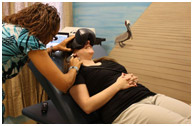
WE CAN HELP YOU, CALL US
+033 2463 0237 /
+91 98300 46401 /
90380 77790 /
89102 58067

WE CAN HELP YOU, CALL US
+033 2463 0237 /
+91 98300 46401 /
90380 77790 /
89102 58067
Vestibular tests are tests of function. Their purpose is to determine if there is something wrong with the vestibular portion of the inner ear. If dizziness is not caused by the inner ear, it might be caused by disorders of the brain, by medical disorders such as low blood pressure, or by psychological problems such as anxiety. Recent studies have suggested that vestibular tests are more accurate than clinical examination in identifying inner ear disorders
The vestibular evoked myogenic potential (VEMP or VsEP) is a neurophysiological assessment technique used to determine the function of the otolithicorgans (utricle and saccule) of the inner ear. It complements the information provided by caloric testing and other forms of inner ear (vestibular apparatus) testing.

Electronystagmography (ENG) is a diagnostic test to record involuntary movements of the eye caused by a condition known as nystagmus. It can also be used to diagnose the cause of vertigo, dizziness or balance dysfunction by testing the vestibular system.
• Caloric tests:
The caloric test is a part of the ENG. It is an attempt to discover the degree to which the vestibular system is responsive and also how symmetric the responses are, between left and right ears. It is a test of the lateral semicircular canals alone -- it does not assess vertical canal function or otolithic function.

The electrocochleography test is an objective measure of the electrical potentials generated in the inner ear as a result of sound stimulation. This test is most often used to determine if the inner ear (cochlea) has an excessive amount of fluid pressure.
